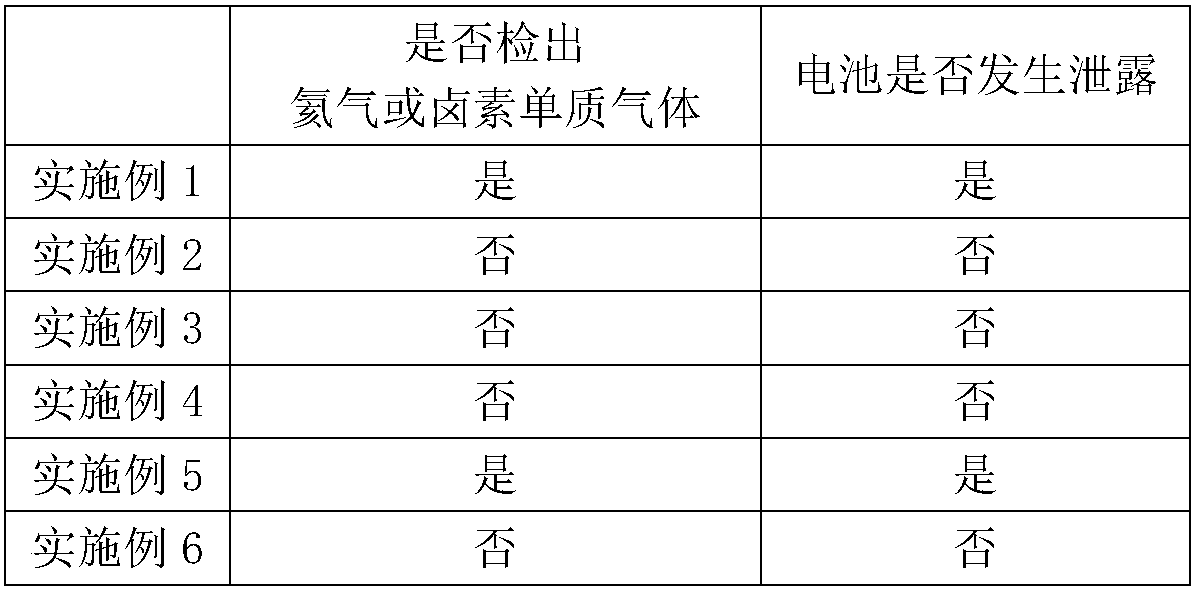Secondary battery leakage detection method
A secondary battery and leak detection technology, which is applied in secondary battery repair/maintenance, battery/battery leak test, and by detecting the appearance of fluid at the leak point, etc., can solve the problems of low detection efficiency, high price, equipment and environment Require high-level problems to achieve the effect of high detection rate, high sensitivity and short time
- Summary
- Abstract
- Description
- Claims
- Application Information
AI Technical Summary
Problems solved by technology
Method used
Image
Examples
Embodiment 1
[0024] This embodiment provides a battery leak detection method, including the following steps:
[0025] Step 1, dissolving the mixed gas containing 5% helium in the electrolyte solution by high-pressure method, then injecting the electrolyte solution into the battery and completing the packaging of the battery;
[0026] Step 2, place the battery obtained in Step 1 in a closed container equipped with a helium gas spectrometer, evacuate the container to a vacuum degree of -20Kpa, keep the pressure for 120s, and then fill it with air, and cycle 2 times like this;
[0027] Step 3, turn on the helium gas spectrometer, check the gas extracted from the airtight container, and judge whether the battery has liquid leakage according to whether helium gas is detected.
Embodiment 2
[0029] This embodiment provides a battery leak detection method, including the following steps:
[0030] Step 1, dissolving the mixed gas containing 10% halogen elemental gas in the electrolyte solution by high-pressure method, then injecting the electrolyte solution into the battery and completing the packaging of the battery;
[0031] Step 2, place the battery obtained in Step 1 in a closed container equipped with a halogen mass spectrometer, evacuate the container to a vacuum degree of -40Kpa, and keep the pressure for 100s, then fill it with nitrogen, and cycle 2 times like this;
[0032] Step 3, turn on the halogen mass spectrometer, check the gas extracted from the airtight container, and judge whether the battery has liquid leakage according to whether the halogen elemental gas is detected.
Embodiment 3
[0034] This embodiment provides a battery leak detection method, including the following steps:
[0035] Step 1, dissolving the mixed gas containing 15% halogen elemental gas in the electrolyte solution by high-pressure method, then injecting the electrolyte solution into the battery and completing the packaging of the battery;
[0036] Step 2, place the battery obtained in Step 1 in a closed container equipped with a halogen mass spectrometer, evacuate the container to a vacuum degree of -60Kpa, keep the pressure for 80s, and then fill it with argon, and cycle 3 times like this;
[0037] Step 3, turn on the halogen mass spectrometer, check the gas extracted from the airtight container, and judge whether the battery has liquid leakage according to whether the halogen elemental gas is detected.
PUM
 Login to View More
Login to View More Abstract
Description
Claims
Application Information
 Login to View More
Login to View More - R&D
- Intellectual Property
- Life Sciences
- Materials
- Tech Scout
- Unparalleled Data Quality
- Higher Quality Content
- 60% Fewer Hallucinations
Browse by: Latest US Patents, China's latest patents, Technical Efficacy Thesaurus, Application Domain, Technology Topic, Popular Technical Reports.
© 2025 PatSnap. All rights reserved.Legal|Privacy policy|Modern Slavery Act Transparency Statement|Sitemap|About US| Contact US: help@patsnap.com

